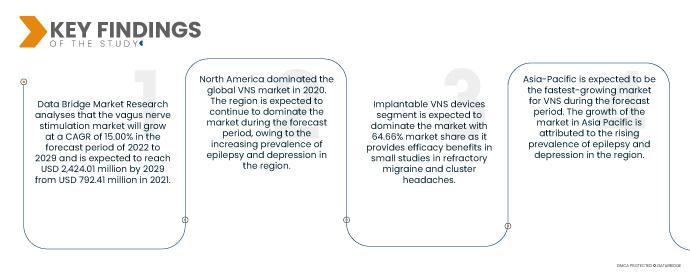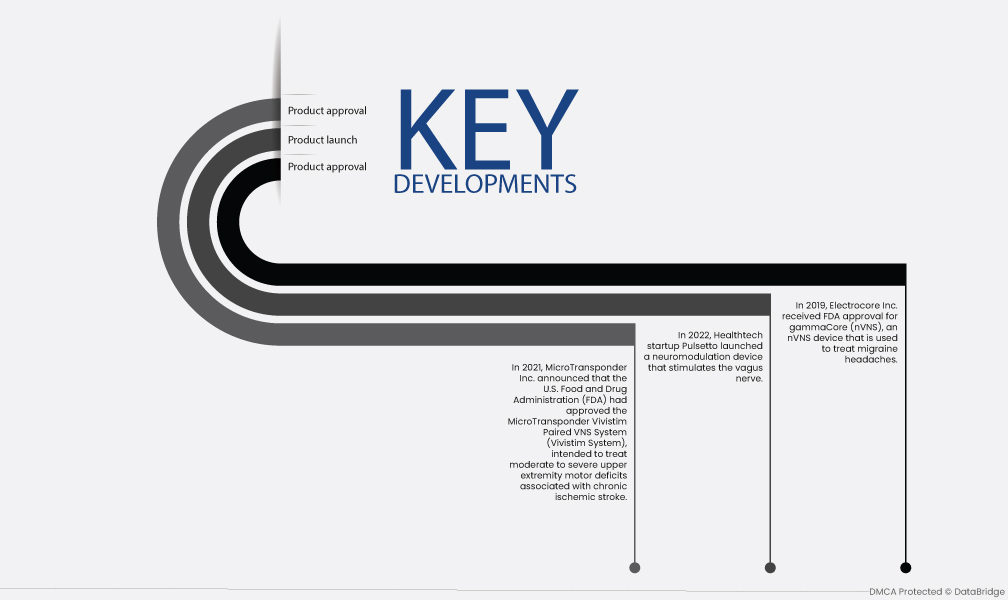O nervo vago é um nervo longo que vai do tronco cerebral até ao abdómen. Desempenha um papel na regulação de muitas funções corporais, incluindo o ritmo cardíaco, a pressão arterial e a digestão. A estimulação do nervo vago (ENV) é um procedimento médico que implica a implantação de um dispositivo que envia impulsos elétricos para o nervo vago. Esta terapia demonstrou ser eficaz no tratamento de uma variedade de distúrbios neurológicos, incluindo epilepsia, depressão e enxaqueca. A terapia VNS é um tratamento seguro e eficaz para uma variedade de distúrbios neurológicos. É um procedimento minimamente invasivo que tem o potencial de melhorar a qualidade de vida de muitos doentes.
Aceda ao relatório completo em https://www.databridgemarketresearch.com/reports/global-vagus-nerve-stimulation-market
A Data Bridge Market Research analisa que o mercado de estimulação do nervo vago crescerá a um CAGR de 15,00% no período previsto de 2022 a 2029 e deverá atingir os 2.424,01 milhões de dólares até 2029, face aos 792,41 milhões de dólares em 2021. Os governos de todo o mundo estão a investir em iniciativas de VNS para melhorar a qualidade, eficiência e acessibilidade dos cuidados de saúde. Estas iniciativas estão a criar novas oportunidades para as empresas de VNS desenvolverem e comercializarem os seus produtos e serviços. Os avanços tecnológicos, como o desenvolvimento de dispositivos implantáveis mais pequenos e mais potentes, estão a tornar a terapia VNS mais acessível e económica. Os doentes exigem cada vez mais a terapia VNS como opção de tratamento para os seus distúrbios neurológicos.
Espera -se que o número crescente de distúrbios neurológicos impulsione a taxa de crescimento do mercado
Os distúrbios neurológicos são uma das principais causas de incapacidade e morte em todo o mundo. Prevê-se que a prevalência destes distúrbios aumente nos próximos anos, devido a fatores como o envelhecimento, a obesidade e fatores ambientais. A VNS é um procedimento minimamente invasivo, o que a torna uma opção atrativa para os doentes relutantes em submeter-se a uma cirurgia tradicional. A terapia VNS tem mostrado resultados promissores no tratamento de vários distúrbios neurológicos, incluindo epilepsia, depressão e enxaqueca.
Âmbito do Relatório e Segmentação de Mercado
Métrica de Reporte
|
Detalhes
|
Período de previsão
|
2022 a 2029
|
Ano base
|
2021
|
Anos Históricos
|
2020 (personalizável para 2014-2019)
|
Unidades quantitativas
|
Receita em milhões de dólares americanos, volumes em unidades, preços em dólares americanos
|
Segmentos abrangidos
|
Tipo de produto (dispositivos VNS implantáveis e dispositivos VNS externos), biomaterial (cerâmico, metálico e polimérico), aplicação (controlo da dor, crises epilépticas, controlo da obesidade, depressão e ansiedade e outros), tipo de doente (adultos, pediátricos e geriátricos), utilizador final (hospitais, centros de cirurgia ambulatória, centros especializados e outros)
|
Países abrangidos
|
EUA, Canadá e México na América do Norte, Alemanha, França, Reino Unido, Holanda, Suíça, Bélgica, Rússia, Itália, Espanha, Turquia, Resto da Europa na Europa, China, Japão, Índia, Coreia do Sul, Singapura, Malásia, Austrália, Tailândia, Indonésia, Filipinas, Resto da Ásia-Pacífico (APAC) na Ásia-Pacífico (APAC), Arábia Saudita, Emirados Árabes Unidos, África do Sul, Egito, Israel, Resto do Médio Oriente e África (MEA) como parte do Médio Oriente e África (MEA), Brasil, Argentina e Resto da América do Sul como parte da América do Sul
|
Participantes do mercado abrangidos
|
Medtronic (Irlanda), LivaNova PLC (EUA), electroCore, Inc. (EUA), Cirtec (EUA), Brain Control Co. Limited (Reino Unido), Soterix Medical Inc. (EUA), SetPoint Medical (EUA), MicroTransponder Inc. (EUA), Parasym Ltd. (Reino Unido) e tVNS Technologies GmbH (Alemanha)
|
Pontos de dados abordados no relatório
|
Além dos insights de mercado, tais como o valor de mercado, a taxa de crescimento, os segmentos de mercado, a cobertura geográfica, os participantes do mercado e o cenário de mercado, o relatório de mercado selecionado pela equipa de pesquisa de mercado da Data Bridge inclui uma análise aprofundada de especialistas, epidemiologia dos doentes, análise de pipeline, análise de preços e estrutura regulamentar.
|
Análise de Segmentos:
O mercado global de estimulação do nervo vago está categorizado em seis segmentos notáveis com base no tipo de produto, biomaterial, aplicação, tipo de paciente, utilizador final e canal de distribuição.
- Com base no tipo de produto, o mercado está segmentado em dispositivos VNS implantáveis e dispositivos VNS externos. Espera-se que o segmento de dispositivos VNS implantáveis domine o mercado com 64,66% de quota de mercado, uma vez que oferece benefícios de eficácia em pequenos estudos sobre enxaqueca refratária e cefaleia em salvas.
- Com base nos biomateriais, o mercado está segmentado em cerâmicos, metálicos e poliméricos. Espera-se que o segmento metálico domine o mercado com 54,64% de quota de mercado devido à sua elevada resistência, elevada tenacidade à fratura, dureza, resistência à corrosão e biocompatibilidade.
- Com base na aplicação, o mercado está segmentado no tratamento da dor, crises epiléticas, tratamento da obesidade, depressão e ansiedade, entre outros. Espera-se que o segmento das crises epiléticas domine o mercado com 48,26% de quota devido ao aumento de lesões cerebrais, problemas de neurodesenvolvimento e predisposições genéticas.
- Com base no tipo de paciente, o mercado está segmentado em adultos, pediátricos e geriátricos. Espera-se que o segmento de adultos domine o mercado com uma quota de mercado de 60,82% devido ao aumento da prevalência de distúrbios neurológicos.
- Com base no utilizador final, o mercado está segmentado em hospitais, centros de cirurgia ambulatória e centros especializados. Prevê-se que o segmento dos centros especializados domine o mercado com uma quota de 51,09% devido ao aumento das áreas de aplicação e ao número crescente de iniciativas governamentais.
O segmento hospitalar dominará o segmento de utilizadores finais do mercado de estimulação do nervo vago
O segmento dos hospitais emergirá como o segmento dominante dos utilizadores finais. Isto deve-se ao número crescente de hospitais no mercado, especialmente nas economias em desenvolvimento. Além disso, o crescimento e a expansão dos serviços de desenvolvimento de investigação à escala global impulsionarão ainda mais o crescimento deste segmento.
- Com base no canal de distribuição, o mercado está segmentado em licitação direta, vendas a retalho e outros. Espera-se que o segmento de licitação direta domine o mercado com 55,46% de quota de mercado, uma vez que cria oportunidades e concorrência no mercado e proporciona um elevado nível de transparência, e a distribuição de dispositivos médicos são os fatores que deverão impulsionar o crescimento do mercado.
O segmento de licitação direta dominará o segmento do canal de distribuição do mercado de estimulação do nervo vago
O segmento de licitação direta surgirá como o segmento dominante no canal de distribuição. Isto deve-se ao número crescente de atividades de desenvolvimento de infraestruturas no mercado, especialmente nas economias em desenvolvimento. Além disso, o crescimento e a expansão do setor da saúde em todo o mundo impulsionará ainda mais o crescimento deste segmento.
Principais jogadores
A Data Bridge Market Research reconhece as seguintes empresas como os principais participantes do mercado: Medtronic (Irlanda), LivaNova PLC (EUA), electroCore, Inc. (EUA), Cirtec (EUA), Brain Control Co. Limited (Reino Unido), Soterix Medical Inc. (EUA), SetPoint Medical (EUA), MicroTransponder Inc. (EUA), Parasym Ltd. (Reino Unido) e tVNS Technologies GmbH (Alemanha).
Desenvolvimento de Mercado
- Em 2021, a MicroTransponder Inc. anunciou que a Food and Drug Administration (FDA) dos EUA aprovou o Sistema VNS Emparelhado MicroTransponder Vivistim (Sistema Vivistim), um sistema de reabilitação sem medicamentos, o primeiro do género, destinado a tratar défices motores moderados a graves dos membros superiores associados ao acidente vascular cerebral isquémico crónico. O Sistema Vivistim é um pequeno dispositivo implantável que fornece pulsos elétricos suaves ao nervo vago, o que ajuda a melhorar o movimento e a função do braço afetado. Após receber a aprovação da FDA, a MicroTransponder começou a comercializar o Sistema Vivistim nos Estados Unidos. Desde então, a empresa reportou fortes vendas do dispositivo, com a receita das vendas do Vivistim a aumentar 50% no primeiro trimestre de 2023.
- Em 2022, a startup de healthtech Pulsetto lançou um dispositivo de neuromodulação que estimula o nervo vago. O dispositivo Pulsetto é um pequeno dispositivo wearable que envia pulsos elétricos suaves para o nervo vago, o que ajuda a melhorar o humor, a reduzir o stress e a promover o relaxamento. O dispositivo Pulsetto baseia-se no princípio da estimulação do nervo vago (ENV), que é uma terapia minimamente invasiva que demonstrou ser eficaz no tratamento de uma variedade de condições, incluindo epilepsia, depressão e ansiedade. O VNS atua estimulando o nervo vago, que é um nervo importante que vai do cérebro até ao estômago.
- Em 2019, a Electrocore Inc. recebeu a aprovação da FDA para o gammaCore (nVNS), um dispositivo nVNS utilizado para tratar enxaquecas. O dispositivo gammaCore é um pequeno dispositivo portátil que proporciona uma curta explosão de estimulação elétrica ao nervo vago. A estimulação foi concebida para bloquear a transmissão dos sinais de dor para o cérebro. O dispositivo gammaCore é uma alternativa não invasiva aos tratamentos tradicionais para a enxaqueca, como medicamentos e cirurgia. O dispositivo é fácil de utilizar e pode ser utilizado em casa ou em qualquer lugar. A Electrocore informou que o dispositivo gammaCore foi bem recebido pelos pacientes e a empresa está a trabalhar para expandir a disponibilidade do dispositivo para pacientes em todo o mundo.
Análise Regional
Geograficamente, os países abrangidos pelo relatório de mercado são os EUA, Canadá e México na América do Norte, Alemanha, França, Reino Unido, Holanda, Suíça, Bélgica, Rússia, Itália, Espanha, Turquia, Resto da Europa na Europa, China, Japão, Índia, Coreia do Sul, Singapura, Malásia, Austrália, Tailândia, Indonésia, Filipinas, Resto da Ásia-Pacífico (APAC) na Ásia-Pacífico (APAC), Arábia Saudita, Emirados Árabes Unidos, África do Sul, Egito, Israel, Resto do Médio Oriente e África (MEA) como parte do Médio Oriente e África (MEA), Brasil, Argentina e Resto da América do Sul como parte da América do Sul.
De acordo com a análise de pesquisa de mercado da Data Bridge:
A América do Norte é a região dominante no mercado de estimulação do nervo vago durante o período previsto de 2022-2029
A América do Norte dominou o mercado global de VNS. Prevê-se que a região continue a dominar o mercado durante o período previsto, devido à crescente prevalência de epilepsia e depressão na região. Os Estados Unidos são o maior mercado de VNS nas Américas, seguidos pelo Canadá e pelo México.
Estima-se que a Ásia-Pacífico seja a região de crescimento mais rápido no mercado de estimulação do nervo vago no período previsto de 2022-2029
Espera-se que a Ásia-Pacífico seja o mercado de crescimento mais rápido para o VNS durante o período previsto. O crescimento do mercado na Ásia-Pacífico é atribuído à crescente prevalência de epilepsia e depressão na região, bem como à crescente aceitação de terapias minimamente invasivas. A China, a Índia e o Japão são os principais mercados para o VNS na Ásia-Pacífico.
Para obter informações mais detalhadas sobre o relatório de mercado sobre a estimulação do nervo vago, clique aqui – https://www.databridgemarketresearch.com/reports/global-vagus-nerve-stimulation-market












